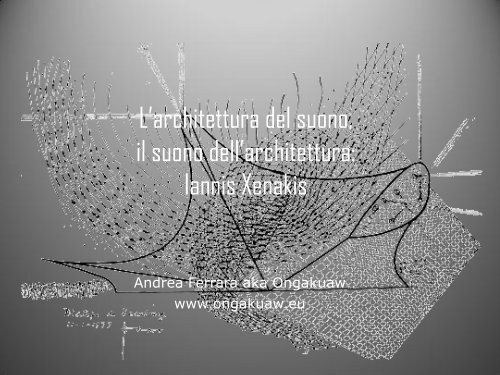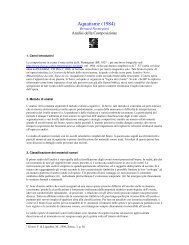L'architettura del suono, il suone dell'architettura
L'architettura del suono, il suone dell'architettura
L'architettura del suono, il suone dell'architettura
You also want an ePaper? Increase the reach of your titles
YUMPU automatically turns print PDFs into web optimized ePapers that Google loves.
L’architettura <strong>del</strong> <strong>suono</strong>,<br />
<strong>il</strong> <strong>suono</strong> <strong>del</strong>l’architettura:<br />
Iannis Xenakis<br />
Andrea Ferrara aka Ongakuaw<br />
www.ongakuaw.eu
Iannis Xenakis: musicista, architetto, ingegnere, f<strong>il</strong>osofo<br />
1922 Romania<br />
1947 Parigi, Studio Le Courbusier<br />
1945 Resistenza greca: combattente<br />
1950 Studia con Messiaen e Scherchen<br />
1948 Condanna a morte in es<strong>il</strong>io<br />
1940 Atene, Ingegneria al Politecnico<br />
1957 Progetto Padiglione Ph<strong>il</strong>ips<br />
2001 Parigi<br />
1991 GENDY<br />
1963 Scrive Musiques Formelles<br />
1966 Montreal, primo Polytope<br />
1974 Primo ritorno ad Atene<br />
1976 Parigi, Dottorato di Stato<br />
1982 Cavaliere <strong>del</strong>la Legion d’Onore
Nello studio di Le Corbusier<br />
Inizialmente assunto (1947) come ingegnere<br />
per la sua conoscenza <strong>del</strong> cemento armato<br />
L’unico scopo per IX era di avere un lavoro giornaliero che gli<br />
permettesse di dedicarsi alla musica nel tempo libero<br />
Nel 1959 viene licenziato e trova <strong>il</strong> lucchetto <strong>del</strong>la porta <strong>del</strong>lo studio<br />
cambiato<br />
“Modern architecture in France has triumphed: it has finally been adopted. Now, it is possible for you to<br />
find new fields to apply what you have learned by yourselves, as well as what your work with me has<br />
brought to you. I believe it behooves each of you to take advantage of any opportunity that arises or<br />
that you may induce Therefore I render you free as of September 1, 1959<br />
- Le Corbusier
Progetti architettonici<br />
La Cité Radieuse, Marse<strong>il</strong>le (1947-53)<br />
Housing Project
Progetti architettonici<br />
The Chandigarh Project, Punjab (1951-59)<br />
The Capitol<br />
Iperboloide
Progetti architettonici<br />
La Tourette, Lyon (1954-60)<br />
Monastero Domenicano<br />
“One thing I have learned from architecture […] is to consider the overall shape of the composition […] ; instead of starting from a<br />
deta<strong>il</strong>, like a theme and bu<strong>il</strong>ding up the whole thing with rules, you have the entire thing in mind and think about the deta<strong>il</strong>s, elements and<br />
proportions”
Idee architettoniche<br />
Griglia climatica<br />
Enumerazione ed analisi <strong>del</strong>le condizioni climatiche per indirizzare le ricerche architettoniche<br />
verso soluzioni in accordo con la biologia umana.<br />
temperatura<br />
umidità<br />
vento<br />
radiazione termica<br />
CONDIZIONI AMBIENTALI CORREZIONI NECESSARIE SOLUZIONI ARCHITETTONICHE
Idee architettoniche…<br />
Pannelli di vetro ondulatori<br />
Aggiunta di un elemento ritmico allo spazio architettonico che riduce i costi e garantisce<br />
<strong>il</strong>luminazione ottimale. Una soluzione musicale (poliritmia) ad un problema costruttivo.<br />
strutture a onda
..basate su idee musicali<br />
Battimenti <strong>del</strong>le onde sonore<br />
Frequenza<br />
Matematicamente<br />
f f <br />
Modulante Portante<br />
y(t) y 1 y 2 2y 0 cos [k x – t] sin (kx – t)<br />
k k 1 – k 2 =(1/ 1 - 1/ 2) 1 – 2 =(f 1 - f 2)
..basate su idee musicali<br />
2<br />
3<br />
4<br />
6<br />
Battimenti<br />
<strong>suono</strong><br />
architettura<br />
| | | | | | | | | | | | | | | | | | | | | | | | | | |<br />
| | | | | | | | | | | | | | | | | | | | |<br />
| | | | | | | | | | | | | | | | |<br />
| | | | | | | | | | | | |<br />
| | | | | | | | | | | | | | | | | | | | | | | | | | | | | | | | | | | | | | | | | | | | |<br />
|<br />
Sovrapposizione
In pratica, all’ascolto<br />
Uso musicale dei battimenti<br />
Studio a due<br />
frequenze<br />
P. Grossi,<br />
Battimenti (1965)<br />
Studio a tre<br />
frequenze<br />
Studio a quattro<br />
frequenze<br />
Studio a cinque<br />
frequenze
Il Modulor L’architettura è musica congelata<br />
2.26 m<br />
1.83 m<br />
1.13 m<br />
0.00 m<br />
- J. W. von Goethe<br />
2<br />
1.61 <br />
1<br />
0
Il rapporto aureo<br />
a +b sta ad a come a sta a b<br />
(a+b)/a = a/b b 2 + ab - a 2 = 0 b = ( 5 –1) a / 2<br />
= (a+b) / a = (1 + 5 ) / 2 = 1.618033…<br />
Rapporto Aureo
Il rapporto aureo e la serie di Fibonacci<br />
= 1.618033…<br />
0, 1, 1, 2, 3, 5, 8, 13, 21, 34, 55, 89, 144, 233, 377, 610, 987, …<br />
Serie di Fibonacci<br />
Formula di Binet<br />
Per grandi n, <strong>il</strong> rapporto tra i termini <strong>del</strong>la<br />
serie di Fibonacci approssima <strong>il</strong> Rapporto Aureo
La spirale aurea
Il rapporto aureo
Metastaseis (1953-54)<br />
Per orchestra sinfonica<br />
61 elementi (46 archi, 12 fiati, 3 percussionisti/7 strumenti)<br />
Ognuno dei musicisti suona una parte unica<br />
Basato sui concetti <strong>del</strong> Modulor/Serie di Fibonacci<br />
Il tempo diventa “relativo” ed è incorporato nel <strong>suono</strong>:<br />
• Le durate sono proporzionali all’altezza<br />
• Le durate seguono progressioni geometriche (“scale di tempo”)<br />
• Le durate si sommano<br />
1 2 3 5 8 13 21 34 55<br />
..altre divisioni fini<br />
con suoni fissi in pizzicalo<br />
con suoni fissi in tremolo<br />
numero di battute<br />
con glissandi<br />
con suoni fissi<br />
con suoni fissi eseguiti con arco<br />
Fibonacci
Metastaseis (1953-54)<br />
Per orchestra sinfonica<br />
Prima rappresentazione a Donaueschinge (1955)<br />
61 elementi (46 archi, 12 fiati, 3 percussionisti/7 strumenti)<br />
Ognuno dei musicisti suona una parte unica<br />
METASTASEIS (09’ 03”)<br />
Iannis Xenakis, 1953-54<br />
glissandi
La sintesi: <strong>il</strong> Padiglione Ph<strong>il</strong>ips<br />
• Esposizione Universale di Bruxelles 1958 (Expo’58)<br />
• Commissionato dalla Ph<strong>il</strong>ips a Le Courbusier<br />
• Installazione multimediale celebrativa <strong>del</strong> progresso tecnologico<br />
• Composizione sonora [Poème électronique, 8 min] commissionata a Edgar Varèse<br />
• Interludio [Concrète PH, 3 min] tra eventi scritto da IX<br />
• All’interno <strong>del</strong> Padiglione:<br />
Proiezioni multiple<br />
Luci ambientali<br />
Manichino femmin<strong>il</strong>e, oggetto matematico (appesi)<br />
350 altoparlanti con spazializzazione sonora<br />
Fotografie proiettate alle pareti<br />
Prima opera intrinsecamente multimediale<br />
oggetto matematico
La sintesi: <strong>il</strong> Padiglione Ph<strong>il</strong>ips
La sintesi: <strong>il</strong> Padiglione Ph<strong>il</strong>ips
VEP: Virtual Electronic Poem<br />
Progetto Europeo, co-fondato dalla Unione Europea (Cultura<br />
2000) per la realizzazione di un ambiente di realtà virtuale<br />
capace di riprodurre l’esperienza globale <strong>del</strong> Padiglione Ph<strong>il</strong>ips<br />
con visione stereoscopica e audio binaurale e multi-canale.<br />
Project leader: Vincenzo Lombardo<br />
Virtual Reality & Multi Media Park<br />
Materiali ed informazioni: http://www.edu.vrmmp.it/vep/
Da Metastaseis al Padiglione Ph<strong>il</strong>ips<br />
Partitura di Metastaseis Schizzo <strong>del</strong> Padiglione Ph<strong>il</strong>ips
Concrèt Ph per <strong>il</strong> Padiglione Ph<strong>il</strong>ips<br />
CONCRET PH (02’ 47”)<br />
Iannis Xenakis, 1958<br />
Suoni di carbone bruciante trasformato attraverso<br />
vari tipi di manipolazioni su nastro magnetico.
Polytope de Montreal (1967)<br />
Polytope de Cluny (1972)<br />
Oltre <strong>il</strong> Padiglione Ph<strong>il</strong>ips: Polytopes<br />
Idea chiave degli anni successivi<br />
Artist-conceptor: someone capable of creating “new abstract and free forms, tending towards complexities, and then towards generalizations<br />
on several levels of organization”<br />
Polytope de Persepolis (1971)<br />
Polytope de Mycenes (1978)
www.ongakuaw.eu



